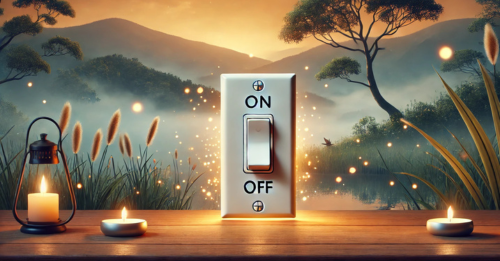The On-Off Switch

By Piero Falci, Mindful Leader MBSR Instructor
“Show up and choose to be present. Pay attention to what has heart and meaning. Tell the truth without blame or judgment. Be open to outcome, not attached to outcome.”
~ Angeles Arrien
When I talk about mindfulness I like to make a distinction between mindfulness meditation and mindful living, or what some teachers refer to as formal and informal meditation.
If we compare mindfulness to a sport, then mindfulness meditation is the practice and mindful living is the game. We practice mindfulness meditation in order to live more mindfully. We practice it in order to develop certain abilities such as the aptitude to be awake, alert, attentive, aware, and appreciative, all qualities that we can use during the other moments of our lives when we are not formally meditating. To put it briefly, we don’t meditate to become good meditators; we meditate to enhance the quality of our lives, and to show up in the world as more conscientious individuals who make choices that enhance the welfare of all beings.
I like to caution those who are trying to live more mindfully about the On-Off switch. I ask them to observe the difference between the moments when they are meditating and the moments when they are not. I encourage them to notice the difference between being mindful and being mindless, present and absent, awake and asleep. I ask them to notice how they keep the mindfulness switch in the On position during meditation, and how often they move it to the Off position as soon as the meditation practice is over. I tell them that it’s not because the formal meditation is over that they should act as if they were given a pass to immediately return to their mindless ways of being.
We should carry the mindfulness we cultivated during the meditation with us like people from times past carried embers. For those of you who are not familiar, embers are hot coals that radiate heat long after a fire has been extinguished and that can be used to relight a fire, or initiate a new one. In the past, when fire was so important for survival, nomads would carefully carry the embers with them in order to light the next fire. In a similar fashion, we are called to watchfully carry the mindfulness ember with us after the meditation is over, so we have it at hand to use it when it may be most needed. It would be beneficial to ask ourselves, “Do I bring the same level of awareness that I experienced during the formal meditation with me after the practice is over?”
It is important to set the intention to maintain oneself in the mindful state developed during the meditation session once the practice is over. For that reason, awareness during the final moments of the meditation practice, those moments when we transition from mindfulness meditation to mindful living, are of the utmost importance
In a way, formal meditation would not be necessary if we were able to live mindfully without any practice, because our ultimate goal is not to meditate, but to live mindfully. That’s why, when asked, “How many hours a day do you meditate?” many experienced practitioners answer, “I meditate all the time. My life is my practice.” This being said, we must acknowledge that practice brings about progress, and that dedicated formal mindfulness meditation practice develops the aptitudes and creates the conditions that allow us to live more mindfully.
Awareness is noticing and knowing what is going on. Right now, is your mindfulness switch On or Off? Check frequently and make sure it is On. Continuity of awareness is what we want to cultivate. A state of non-interrupted mindfulness is what we gently strive for.

0 comments
Leave a comment